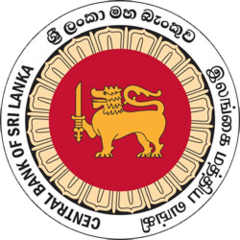 CENTRAL BANK OF SRI LANKA
CENTRAL BANK OF SRI LANKA
Central Bank of Sri Lanka is the monitory authority of Sri Lanka and the apex institution in the country's financial sector. it was established in 1950 under the monitory Law Act No.58 of 1949. it is a government-owned semi-autonomous body, and amendments to the Monitory Law Act in December 2002,is governed by five-member Monitory Board, comprising the governor as chairman, the secretary to the Ministry of Finance and planning, and three members appointed by the president of Sri Lanka, on the recommendation of the minister of finance, with the concurrence of the constitutional Council.
Vision
" A credible and dynamic bank contributing to the prosperity of Sri Lanka."
Mission
"Maintaining economic and price stability and financial system to support sustainable growth through policy stimulus, advice, commitment and excellence."
Objective of the Central Bank
There are two main objective of the Central Bank. then,
• Maintaining economic and price stability
• Maintaining financial system stability
The two objectives are correlated and complement each other. Ensuring financial system stability is of prime importance as monetary policy is transmitted through financial intermediaries (institutions) to achieve price stability. Price stability is important for financial system stability as interest rates, exchange rates and other asset prices move in response to changes in the general price level, impacting on the risk profile of financial institutions. Economic, price and financial system stability are necessary for sustained economic growth.
Price stability –
Price stability is interpreted to mean low and stable inflation. Low inflation or price stability fosters sustainable long-term economic growth and employment. The CBSL uses monetary policy measures to control inflation
Financial system stability-
Financial system stability can be defined as the ability of the financial system to perform its main functions of resource mobilization and allocation, risk management and the settlement of payments, effectively at all times, even under stressful circumstances. Therefore a stable financial system is typically characterized by the effective functioning of financial institutions, markets and infrastructure.
Function of Central Bank of Sri Lanka
Core Functions
(a) Conduct of monetary policy.
The CBSL conducts monetary policy to maintain price stability in the domestic economy. Monetary policy operates primarily by influencing the cost and/or availability of money. This is done through the interest rate and the credit availability mechanism.
(b) Conduct of exchange rate policy.
A flexible exchange rate system was adopted in June 2001. The exchange rate is determined by market forces of demand and supply, reflecting the macroeconomic fundamentals in the economy. The CBSL may intervene in the foreign exchange market to prevent excessive volatility in exchange rates and to maintain a comfortable level of external reserves
(c) Management of the official international reserves.
The CBSL manages the official international reserves of the country. The MLA stipulates that the CBSL should maintain adequate foreign exchange reserves in liquid foreign currencies and a small reserve in gold to maintain the international stability of the Rupee and freedom in current international transactions.
(d) Oversight of the financial system.
As part of its mandate of financial system stability, the CBSL undertakes surveillance and oversight of the entire financial system taking into account its interaction with the real economy to monitor and limit systemic risks which could lead to financial and economic crises
(e) Licensing, regulation and supervision of banks and selecting non – bank financial institutions.
The CBSL is responsible for regulating and supervising banks and selected non-bank financial institutions to promote their soundness and to safeguard the interests of depositors and investors. The regulation and supervision of individual financial institutions is referred to as micro prudential policy
(f) Provision of settlement facilities and the regulation of the payment system.
The maintenance of a well-functioning and secure payment and settlement system is an essential ingredient for a stable financial system. In terms of the Payment and Settlement Act, the CBSL is authorized to regulate and supervise payment, clearing and settlement systems.
(g) Issue and distribution of the national currency.
The CBSL has the exclusive right to issue currency notes and coins that are the legal tender in Sri Lanka. There is no maximum limit imposed on the issue of currency. The issue of currency is primarily based on the transaction demand for money.
(h) Compilation and dissemination of economic data and statistics
.
The CBSL compiles statistics required to formulate macro-economic policies and disseminates information on the economy to the public. This includes statistics on money, banking and the financial sector, balance of payments, national income, prices, wages and employment, agriculture, industry, trade and services, government finance and public debt. The CBSL also conducts economic, financial and business surveys.
(i) Acting as the banker and financial adviser to the Government.
As banker to the Government, the CBSL maintains the accounts of and provides banking facilities to Government departments, agencies, institutions and certain statutory boards. The CBSL may give guarantees in favor of the Government. The CBSL also provides provisional advances to the Government.
Agency Functions
In addition, the CBSL also performs the following agency functions on behalf of the Government of Sri Lanka:
(a) Management of the public debt.
(b) Foreign exchange management.
(c) Fund management and acting as the custodian of the Employees’ Provident Fund.
(d) Facilitating financial inclusion.
(e) Financial intelligence services to detect and prevent money laundering and terrorist financing.